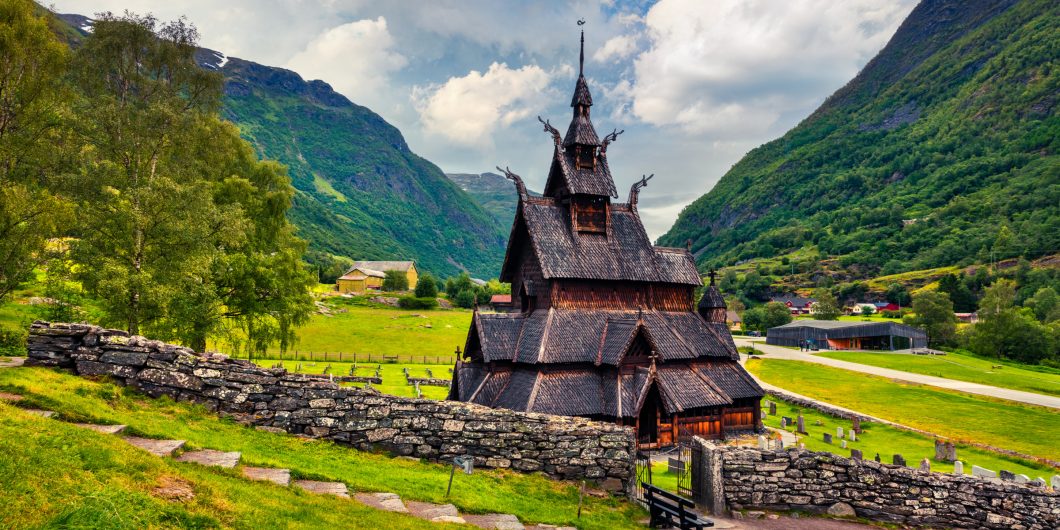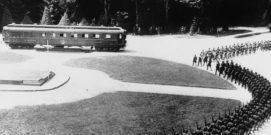Portrait of an artist as a young man, under Nazi and then communist rule.
Misdirected Passion
Perhaps a hundred years ago feels too distant to be relevant. How much more disconnected does seven hundred years ago feel? Yet, when reporters asked Sigrid Undset why she wrote medieval sagas, the Nobel Prize winning novelist answered, “You can only write novels of your own age.” Published in three volumes between 1920-1922, Kristin Lavransdatter grants readers a vision of the human self that is perpetually true, searing though it is. No one who reads the novel would dare call it a relic of the 20th century (or worse, a story from a faraway, irrelevant time). At its centenary, we should cling to this novel for its honesty, beauty, and its haunting depiction of a soul in progress of sanctification.
Rarely do we receive the epic journey of a life from womb to tomb, and even more rarely do we witness such heroics in the form of a female protagonist. In our age of plague, what’s better than to read about the Black Death? In our age of isolation, what should inspire us more than a story about friendship and family? With every turn of the page, every gut-wrenching moment of misplaced passion, every grief over loved ones lost and over memories past never to be relived, the novel proves Undset right—its age is our own.
Despite her Nobel Prize, Sigrid Undset is an underappreciated novelist, who we celebrated for her genius and talent far too late. She lived during the same era as other notable women intellectuals as Dorothy Sayers, Anna Julia Cooper, Edith Stein, and Simone Weil, and like them did not receive the same opportunities offered to her as to men of her time. When her father died when she was only eleven, her mother and siblings were thrown into poverty. Undset began working as a secretary as soon as she could to help with finances, and she wrote fiction in her spare time. In one of the most humorous oversights in publishing, an editor rejected her first attempt at a medieval novel and advised her to try a more realistic story. She published a handful of these realistic stories before returning to the Middle Ages and composing Kristin Lavransdatter and The Master of Hestviken. Both of these sold well enough to pull her out of poverty and provide for her family; they also earned her the recognition by the Nobel Prize committee in 1928. She gave away all of the prize money to children’s charities.
In 1940 Undset was forced to flee her home because of the Nazi occupation of Norway. She had been an active opponent of the Nazis even before they invaded. Her son died in action fighting for Norway. While the Gestapo set up headquarters at her Lillehammer home, Undset took up residence in New York as an exile, writing anti-German articles for St. Ansgar’s Scandinavian Catholic League. She recorded her journey in a memoir titled Return to the Future: An Escape to Freedom. When Undset returned to Norway after the war, she felt haunted by those who had inhabited her home during her absence. Her daughter had died before the outbreak of the war. All that remained to her was her youngest son, and the loss of her children weighed heavy upon her. She wrote a biography of Catherine of Siena, which was rejected by Doubleday and only posthumously published. She died on June 10, 1949, alone at her home.
Kristin Lavransdatter follows the course of a young girl’s life from her earliest years to her death of the plague as a fifty-year-old woman. Her story is not exceptional because of its plot points—though it reads with as much excitement as any HBO series—but because of the struggle of her will, the internal battle that readers experience with Kristin throughout her life. The tension of the divided self is as old as Augustine, but only our culture seems to want to dismiss this struggle as illusory. Kristin begins bucking at convention from a young age. She’s drawn to a vision of an elf maiden in the mountains as much as the Virgin Mary painted in stained glass in the cathedral windows. She wants to please her father whom she loves, but she rejects his proposed suitor and brings shame on her family by giving herself to a disreputable man before marriage. As she confesses to a priest near the end of the story, “All my days I have longed equally to travel the right road and to take my own errant path.” For Kristin, good and evil are equally compelling, and the latter she associates with her own ways.
We often think of saints as being passionless creatures, but as Peter Kreeft once pointed out, saints begin as the most passionate of sinners. They have so much passion and zeal, but they misdirect the energy towards what they see as their own good before turning it towards God. Kristin represents such a passionate but misdirected saint-in-progress. When a monk, Brother Edvin, asks if she would like to dedicate her beauty to God and join the convent, she refuses the proposal. Instead of being the bride of Christ, Kristin joins herself to Erlend Nikulausson, who is an excellent lover but a poor husband. Kristin laments, “I didn’t realize then that the consequence of sin is that you have to trample on other people.” She suffers the consequences of her choices for most of her life: becoming complicit in murder, raising headstrong and temperamental sons, enduring the confiscation of their royal estate, and even the loss of her husband who dies for her maligned honor.
When, in the end, Kristin becomes a nun in a convent, she feels little will in this choice. “The world was a master from whom it was difficult to flee once a person had submitted to its power,” Kristin reflects. “Surely she would not have fled either, but she had been cast out, the way a harsh master chases a used-up vassal out the door.” In another moment, she compares the world to an alehouse: “The person who has no more to spend is thrown outside the door.” The beauty that led Kristin to sin has faded. As mistress of Husaby, confidence had been required to run her estate. Yet such virtue will not be required to tend convent gardens. Kristin discovers what George Bernanos calls the “miracle of empty hands,” that we have nothing to give but ourselves, and God works through such empty vessels for His good.
When Sigrid Undset wrote Kristin Lavransdatter, she was not a Christian. She had read Catholic writers such as G.K. Chesterton (perhaps had even heard him lecture during the year she spent in London) and had translated The Friendship with Christ by Robert Hugh Benson. But it was not until writing Kristin Lavransdatter that Undset felt convicted to enter the Roman Catholic Church in 1924. When people inquired what led her to the faith, she confessed that spending all that time in the company of saints and writing their stories brought her into the church. How to spend years with God’s friends and not want to be one? As a Dominican tertiary, Undset took the name “Olave,” a feminized form of Olav, the first holy king of Norway. The icons of St. Olav show him with an axe in one hand and a cross in the other, a fitting image of both Kristin and Undset’s characters, both the one who fights and the one who suffers.
When we finish Undset’s story, we should not feel satisfied but hungry—that we may want more, be more, and do more for this time and place that we find ourselves. Like Kristin, we should be restless when we receive the goals of our own will and only rejoice when our wills have sought and found something much higher.
By the time the story takes us to Kristin’s deathbed, we feel a real loss, for we have known her for decades. Yet, we do not mourn, for she goes into death knowing “a love that had been poured over her—and in spite of her willfulness, in spite of her melancholy, earthbound heart, some of that love had stayed inside her, had worked on her like the sun on earth, had driven forth a crop that neither the fiercest fire of passion nor the stormiest anger could completely destroy.” Her death is a victory that we vicariously experience even a hundred years after it was written. Even though it is fiction, her death feels truer than truth.
In Kristin Lavransdatter we see a life that resembles our own, full of desires for the good she ought to do and all the things she knows she should not want. Through Kristin’s childhood, her youthful romance, her stormy marriage, the intimate realities of motherhood and its struggles, as well as her wrestling with old age and its potential uselessness, we are drawn out of the middle of our lived stories to imagine the complete life. If I live another ten or twenty or thirty years, how are the choices that I’m making now affecting my overall narrative? What goods ought I to be pursuing instead of those evils that compete for my desires? How do you want those who come after you to tell your story? If we look closely, we see a reflection of our own age, a muddling of pagan and Christian ideas, a nation haunted by the heroes and villains of the past. In a hundred years, what will they be saying about our age?
If we want to overcome the fallacy of presentism and see beyond the heightened emotion of our current cultural moment, we would do well to read old books, especially books that transport us backwards into even older ages and times. Kristin Lavransdatter invites us to reconsider the world where we reside. The novel acts as a mirror that does not reflect what we want to see but perhaps what we’ve been neglecting, the consequences of our autonomous ways. When we finish Undset’s story, we should not feel satisfied but hungry—that we may want more, be more, and do more for this time and place that we find ourselves. Like Kristin, we should be restless when we receive the goals of our own will and only rejoice when our wills have sought and found something much higher.



